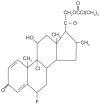Clinical utility of clocortolone pivalate for the treatment of corticosteroid-responsive skin disorders: a systematic review
- PMID: 22791998
- PMCID: PMC3393117
- DOI: 10.2147/CCID.S23227
Clinical utility of clocortolone pivalate for the treatment of corticosteroid-responsive skin disorders: a systematic review
Abstract
Clocortolone pivalate 0.1% cream is a class IV mid-strength topical glucocorticoid. After topical application the glucocorticoid achieves higher concentration in inflamed skin compared with normal skin. Furthermore, pharmacologic studies have shown that there is little systemic absorption of clocortolone pivalate and hence no adrenal suppression. Systematic review was performed to evaluate the efficacy and safety of the glucocorticoid. PubMed, the Cochrane Library, and individual websites of the top 20 dermatology journals were searched using a defined strategy. Following the selection criteria, eight clinical trials were selected, of which five were randomized controlled trials. The trials mainly included patients with atopic dermatitis and eczemas. Quality appraisal of randomized controlled trials was done using the Delphi list, which showed that the trials had weaknesses in several items. The results of the systematic review tend to show that clocortolone pivalate cream is generally effective with early onset of action and has a good safety profile in the treatment of these conditions. Further studies comparing this glucocorticoid with other glucocorticoids and treatments in steroid-responsive dermatoses are desirable.
Keywords: clocortolone pivalate; corticosteroid; glucocorticoid; systematic review.
Figures
Similar articles
-
A Comprehensive Review of Clocortolone Pivalate 0.1% Cream: Structural Development, Formulation Characteristics, and Studies Supporting Treatment of Corticosteroid-responsive Dermatoses.J Clin Aesthet Dermatol. 2012 Jul;5(7):20-4. J Clin Aesthet Dermatol. 2012. PMID: 22798972 Free PMC article.
-
The treatment of inflammatory facial dermatoses with topical corticosteroids: focus on clocortolone pivalate 0.1% cream.J Drugs Dermatol. 2012 Oct;11(10):1194-8. J Drugs Dermatol. 2012. PMID: 23134984 Clinical Trial.
-
Clocortolone pivalate: a topical corticosteroid with a unique structure.J Drugs Dermatol. 2013 Feb;12(2):s3-4. J Drugs Dermatol. 2013. PMID: 23377404
-
Safety and efficacy of clocortolone pivalate 0.1 percent cream in the treatment of atopic dermatitis, contact dermatitis, and seborrheic dermatitis.Cutis. 1981 Jun;27(6):670-1. Cutis. 1981. PMID: 6453703 Review. No abstract available.
-
Sertaconazole: a review of its use in the management of superficial mycoses in dermatology and gynaecology.Drugs. 2009;69(3):339-59. doi: 10.2165/00003495-200969030-00009. Drugs. 2009. PMID: 19275277 Review.
Cited by
-
Safety of topical corticosteroids in atopic eczema: an umbrella review.BMJ Open. 2021 Jul 7;11(7):e046476. doi: 10.1136/bmjopen-2020-046476. BMJ Open. 2021. PMID: 34233978 Free PMC article.
-
Understanding the correlation between structure and dynamics of clocortolone pivalate by solid state NMR measurement.RSC Adv. 2020 Jan 27;10(8):4310-4321. doi: 10.1039/c9ra09866f. eCollection 2020 Jan 24. RSC Adv. 2020. PMID: 35495240 Free PMC article.
References
-
- Brazzini B, Pimpinelli N. New and established corticosteroids in dermatology. Am J Clin Dermatol. 2002;3:47. - PubMed
-
- Valencia IC, Kerdel FA. In: Topical corticosteroids Fitzpatrick’s dermatology in general medicine. 7th ed. Wolff K, Goldsmith LA, Katz SI, Gilchrest BA, Paller AS, Leffell DJ, editors. New York: McGraw-Hill; 2008. pp. 2102–2106.
-
- Greaves MW. In: Pruritus Rook’s textbook of dermatology. 8th ed. Burns T, Breathnach S, Cox N, Griffiths C, editors. Chichester: Wiley-Blackwell; 2010. pp. 21.1–21.18.
-
- . Prescribing information. Cloderm cream 0.1%. [Accessed March 13, 2012]. Available from: http://www.clodermcream.com/ClodermCreamPI.pdf.
-
- Jacob SE, Steele T. Corticosteroid classes: a quick reference guide including patch test substances and cross-reactivity. J Am Acad Dermatol. 2006;54(4):723–727. (IC 1, EC 2) - PubMed
LinkOut - more resources
Full Text Sources


